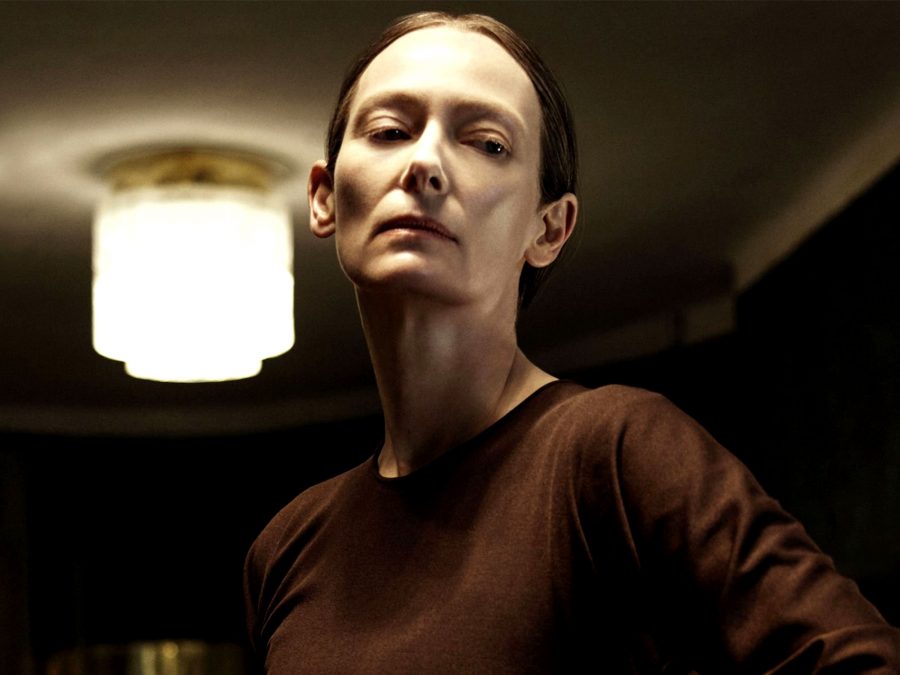
Dakota Johnson dances to an unfamiliar beat in Luca Guadagnino’s surprisingly naff horror remake.
“It’s all a mess, isn’t it,” offers Dakota Johnson towards the end of Suspiria. Well, quite. This is Luca Guadagnino’s bizarre reimagining of Dario Argento’s cult Euro-shocker from 1977. The word ‘cult’ is key, because while the film was something of an unexpected commercial hit in the US – following significant edits made to secure the desired R-rating – it wasn’t until 1988 that the full, uncut version was made available to a wider audience on VHS. So how has Guadagnino translated this classic low-budget gialli – with its ominous sound design, expressionist visuals and crudely overdubbed dialogue – into a big ticket studio offering?
For starters, he’s added an hour to the runtime, arranging the story into six acts and an epilogue. Which is not to say his film packs a bigger phantasmagoric punch. Because although Guadagnino gradually dials up the freaky during the film’s slowburn first hour, it plays out more like a drunken stumble in the dark than a dread-filled danse macabre. And what a dingy, ugly film it is. The Italian director previously teamed up with Thai DoP Sayombhu Mukdeeprom to intoxicating effect in 2017’s Call Me by Your Name, but this time around the cinematography is murky and flat, Guadagnino favouring low-contrast lighting and a muted palette over eye-popping primary colours. The set design, too, is drab and inelegant, diminishing the character and aesthetic impact of the Art Deco interiors.
The setting is Berlin circa 1977. Susie Bannion (Johnson), a shy but prodigious dancer hailing from Ohio, has just joined the world-renowned Markos Dance Academy, run by the austere and mysterious Madame Blanc (Tilda Swinton). Having already made a big impression in her audition, Susie’s talent instantly shines through and she quickly becomes an object of fascination among the all-female staff and students. But then strange things start happening, and there’s a creeping sense that the girls are somehow trapped inside this grand old building – bound not only by its walls but by the concrete structure that divides the city, and which stands just a few metres away from the academy’s front steps. Or perhaps they’re being drawn to something, gripped by an imperceivable, all-powerful force.

There are signs everywhere you look in this film. Some are literal, like a cross-stitched picture spelling out the poetic verse ‘A mother is she who can take the place of others, but whose place no one else can take,’ and a cry of defiance written in graffiti, ‘Freiheit Für Alle’. Others are symbolic, like the unmistakable yonic shapes that appear sporadically throughout (seriously, there is So. Much. Vagina. in this movie). As the main storyline unfolds, seemingly important information about various characters is parcelled out, such as Susie’s Amish upbringing (as if that automatically makes her weird or untrustworthy), without actually telling us anything about them. The script repeatedly emphasises themes of rebirth, religion and everyday human rituals but doesn’t have a great deal to say about any of it.
Guadagnino also draws our attention to the sociopolitical turmoil Germany was experiencing in the late 1970s, intermittently cutting to breaking news reports on the kidnapping and eventual murder of the industrial leader Hanns Martin Schleyer at the hands of the Baader-Meinhof Gang. It’s hard to figure out what exactly Guadagnino and screenwriter David Kajganich are trying to achieve by inserting factual subplots into a supernatural horror centred around a clandestine coven. If making allusions to the Holocaust is their way of elevating proceedings, it doesn’t work. At best, it’s a crass attempt at pathos.
Suspiria is even more bothersome on a technical level. The camera movement seesaws between glacial push-ins and wobbly crash zooms, creating a jarring visual tone. Rapid-cut montages comprising random nightmarish images – a toilet clogged with hair, a woman’s face drenched in blood, an earthworm writhing on a bathroom countertop – amount to very little beyond implying a character’s disturbed psyche. Instances of sub-David Cronenberg body horror are agreeably gruesome but feel stylistically at odds with the rest of the film. The dance choreography is more silly than unsettling. The already infamous scene of bone-snapping mutilation that supposedly prompted walkouts at an early footage preview borders on torture porn, though it’s great to see Guadagnino utilising old-school practical effects. And Goblin’s iconic score from the original is replaced by Radiohead’s Thom Yorke warbling incomprehensibly.
Swinton makes her second appearance in the film (she doesn’t necessarily stop there) as an elderly male psychiatrist named Dr Jozef Klemperer, who lost his wife in the War and is now searching for a missing girl named Patricia (Chloë Grace Moretz in a small, thankless role), a former client and Markos student. Oddly enough the role of Klemperer is officially credited to one Lutz Ebersdorf, an apparently real-life octogenarian first-time actor who even has his own IMDb page. Why bother going to all that trouble when the truth is as plain as the prosthetic nose on Swinton’s face?
At one point Klemperer reads a passage from Patricia’s diary that contains a direct reference to Argento’s ‘Three Mothers’ trilogy: “Mater Tenebrarum, Mater Lachrymarum, Mater Suspiriorum.” These are the names of the ancient evil spirits Patricia believes are behind the ghastly goings on at the academy, and she handily provides an explanation for what each one represents. “Darkness, Tears and Sighs.” Suspiria is certainly a dark film, and it may well cause you to sigh or even bring you to tears. Just not for the reasons you were probably expecting.
Published 1 Sep 2018

Damien Chazelle’s technically accomplished Moon landing drama, starring Ryan Gosling and Claire Foy, fails to achieve lift off.

By Anton Bitel
Forty years on, the director’s nightmarish gialli has lost none of its potency.

Emma Stone and Rachel Weisz vie for Olivia Colman’s affections in this erotic 18th century romp from Yorgos Lanthimos.